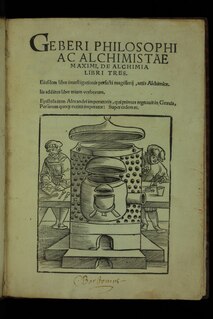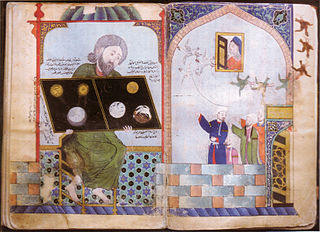See also
- All pages with titles containing Geber
- Gever (disambiguation)
- Jaber (disambiguation)
- Ezion-Geber, a biblical seaport on the northern extremity of the Gulf of Aqaba
Geber is the Latinized form of the Arabic name Jabir. It may refer to:
Gibberish, also called jibber-jabber or gobbledygook, is speech that is nonsense. It may include speech sounds that are not actual words, or language games and specialized jargon that seems nonsensical to outsiders.

Year 815 (DCCCXV) was a common year starting on Monday of the Julian calendar.
Major innovations in materials technology

Jābir ibn Ḥayyān, died c. 806−816, is the purported author of an enormous number and variety of works, often called the Jabirian corpus. The works that survive today mainly deal with alchemy and chemistry, magic, and Shi'ite religious philosophy. However, the original scope of the corpus was vast and diverse, covering a wide range of topics ranging from cosmology, astronomy and astrology, over medicine, pharmacology, zoology and botany, to metaphysics, logic, and grammar.

Vitriol is the general chemical name encompassing a class of chemical compound comprising sulfates of certain metals — originally, iron or copper. Those mineral substances were distinguished by their color, such as green vitriol for hydrated iron(II) sulfate and blue vitriol for hydrated copper(II) sulfate.

Pseudo-Geber refers to a corpus of Latin alchemical writing dated to the late 13th and early 14th centuries, attributed to Geber (Jābir ibn Hayyān), an early alchemist of the Islamic Golden Age. The most important work of the corpus is Summa perfectionis magisterii, likely written slightly before 1310, whose actual author has sometimes been identified as Paul of Taranto. The work was influential in the domain of alchemy and metallurgy in late medieval Europe.

The Emerald Tablet, also known as the Smaragdine Tablet or the Tabula Smaragdina, is a compact and cryptic Hermetic text. It was highly regarded by Islamic and European alchemists as the foundation of their art. Though attributed to the legendary Hellenistic figure Hermes Trismegistus, the text of the Emerald Tablet first appears in a number of early medieval Arabic sources, the oldest of which dates to the late eighth or early ninth century. It was translated into Latin several times in the twelfth and thirteenth centuries. Numerous interpretations and commentaries followed.

The torquetum or turquet is a medieval astronomical instrument designed to take and convert measurements made in three sets of coordinates: Horizon, equatorial, and ecliptic. It is said to be a combination of Ptolemy's astrolabon and the plane astrolabe. In a sense, the torquetum is an analog computer.

Geber is a lunar impact crater that is located in the rugged south-central highlands of the Moon. It lies halfway between the crater Almanon to the north-northeast and the crater pair of Azophi and Abenezra to the south-southwest. Farther to the southeast is Sacrobosco. Geber is 45 kilometers in diameter and 3,510 meters deep.
Gaber may refer to:
Ḥarbī al-Ḥimyarī is a semi-legendary Himyarite sage that occurs several times in the writings attributed to the Islamic alchemist Jābir ibn Ḥayyān. He is said there to have been one of Jabir's teachers, and to have been 463 years old when Jabir met him. One of Jabir's lost works was dedicated to Harbi al-Himyari's contributions to alchemy, a fact which may point to the existence in Jabir's time of a written work attributed to him.
Jabir is an Arabic surname or male given name, which means "comforter". Alternative spellings include Djābir, Jaber, Jābir, Gabir, and Geber. The name may refer to:

Abū Muḥammad Jābir ibn Aflaḥ was an Arab Muslim astronomer and mathematician from Seville, who was active in 12th century al-Andalus. His work Iṣlāḥ al-Majisṭi influenced Islamic, Jewish, and Christian astronomers.
Ibn Hayyan may also refer to:
Eliezer Paul Kraus, 11 December 1904 – 10 or 12 October 1944, was a Jewish Arabist born in Prague. He is the author of a number of seminal works on early Arabic philosophy, with a special focus on Arabic alchemy and chemistry. Some of his writings on this subject are still standard reference works in the field today.

Alchemy and chemistry in Islam refers to the study of both traditional alchemy and early practical chemistry by Muslim scholars in the medieval Islamic world. The word alchemy was derived from the Arabic word كيمياء or kīmiyāʾ and may ultimately derive from the ancient Egyptian word kemi, meaning black.
Abu'l Hasan ibn Arfa Ra's was a Moroccan chemist from the city of Fez, who lived most of his life during the Almohad period. In his works he develops a theoretical and terminological framework of experimental process and basic laboratory techniques still recognizable today.
Tafsir Imam Ja'far al-Sadiq refers to a collection of hadiths reportedly narrated by Ja'far al-Sadiq that comment on the verses of the Qur'an. The approach of these narratives is generally mystical. Initially, they were recited at Sufi circles in Kufa and Baghdad. The first person to have reported this collection is one of Sufi scholars Abu Abd al-Rahman Sulami as part of his Haqaiq al-Tafsir. While Sulami provides parts of the hadiths, Sufi scholar Khargushi provides some other in his Arais al-Bayan fi Haqaiq al-Quran Ruzbihan Baqli.

Pierre Lory is a director of studies at the École pratique des hautes études, holder of the Chair of Muslim mystic of the Ve section, religious sciences.
Harbi may refer to: